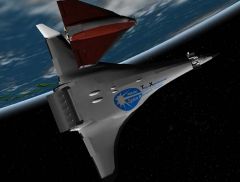TX
|
Project home: TX at orbithangar.com |
| TX | |
|---|---|

| |
| TX and Delta-glider in low Earth orbit | |
| Description | |
| Role | Atmospheric tug |
| Full name | Tug eXperimental |
| Crew | 3 |
| Passengers | none |
| First flight | date unknown |
| Entered service | date unknown |
| Manufacturer | Kulch SRC, but studied by NASA |
| Dimensions | |
| Length | 110.39 m |
| Height | 22.28 m |
| Wingspan | 85.15 m |
| Wing area | - m2 |
| Masses | |
| Empty | 210,000 kg |
| Fuel | 555,000 kg |
| RCS fuel | 10,000 kg |
| Max. take-off | 825,000 kg |
| Inertia PMI | - m2 |
| Performance | |
| Max. delta-v | ? m/s |
| Max. accel | ? m/s2 |
| Stall CL | ? |
| Stall AOA | ?° |
TX (or Tug, Experimental) is the Kulch SRC's experimental winged hypersonic booster. The first of a series of Winged Boosters set to be developed by Kulch, the TX is designed to carry payloads up to 50 tons to low Earth orbit.
The main jet installation consists of 6 combined engines, able to work both in an atmosphere and in space, and 6 space-only engines. The propellant is liquid oxygen and hydrogen. An air shutter is automatically controlled to maintain maximum efficiency of engines during atmospheric flight; once the engines have switched purely to internal oxidizer, the shutter is closed. Main engines have two modes of operation: take-off and orbital. In take-off mode all 12 engines work (in atmospheric flight, 6 engines). In orbital mode such large thrust is not required, so only 4 engines of the 12 (2 engines in atmospheric flight) work. Orbital mode is also used during landing, since almost all fuel is consumed and the TX is lighter than during takeoff.
Kulch SRC is not the original creator of the TX, for it is based on a study by NASA in 1971, with some of the TX's features summarized in the book "The Estimation of Characteristics of Carriers for Space Vehicles"
The TX can carry other light vehicles to orbit; it is designed specifically for the Delta-glider and VTOL-X, but with an appropriate flight profile, it can also be an effective first stage for the Deltaglider EX.